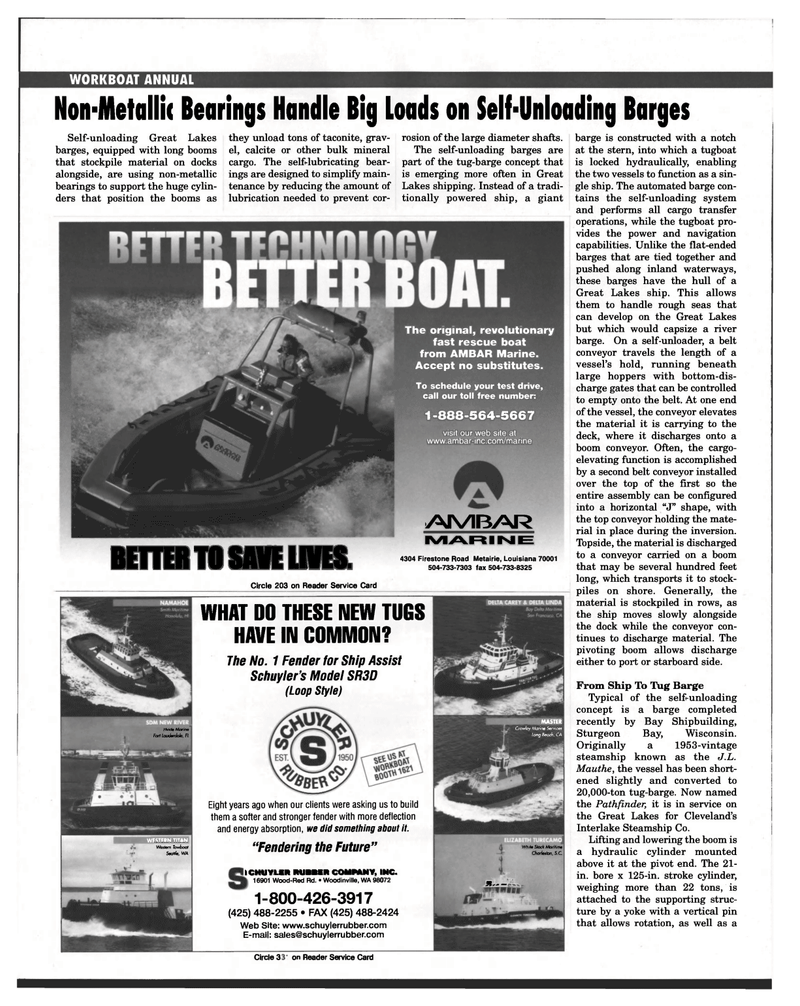
Page 64: of Maritime Reporter Magazine (November 1998)
Read this page in Pdf, Flash or Html5 edition of November 1998 Maritime Reporter Magazine
WORKBOAT ANNUAL
Non-Metalli( Bearings Handle Big Loads on Self-Unloading Barges
The original, revolutionary fast rescue boat from AMBAR Marine.
Accept no substitutes.
To schedule your test drive, call our toll free number: 1 -888-564-5667 visit our web site at www.ambar-inc.com/marine
BETTER TO SAVE LIVES. /WIB/XR
MARINE 4304 Firestone Road Metairie, Louisiana 70001 504-733-7303 fax 504-733-8325
Circle 203 on Reader Service Card
WHAT DO THESE NEW TUGS
HAVE IN COMMON?
The No. 1 Fender for Ship Assist
Schuyler's Model SR3D (Loop Style)
Eight years ago when our clients were asking us to build them a softer and stronger fender with more deflection and energy absorption, we did something about it. 'Tendering the Future"
ICHUYLER RUBBER COMPANY, INC. 16901 Wood-Red Rd. • Woodinville, WA 98072 1-800-426-3917 (425) 488-2255 • FAX (425) 488-2424
Web Site: www.schuylerrubber.com
E-mail: [email protected]
MASTER
Crowley Marine Services
Long Beach. CA
While Stack Maritime
Charleston, S C. n—
WESTERN TITAN
Circle 388 on Reader Service Card barge is constructed with a notch at the stern, into which a tugboat is locked hydraulically, enabling the two vessels to function as a sin- gle ship. The automated barge con- tains the self-unloading system and performs all cargo transfer operations, while the tugboat pro- vides the power and navigation capabilities. Unlike the flat-ended barges that are tied together and pushed along inland waterways, these barges have the hull of a
Great Lakes ship. This allows them to handle rough seas that can develop on the Great Lakes but which would capsize a river barge. On a self-unloader, a belt conveyor travels the length of a vessel's hold, running beneath large hoppers with bottom-dis- charge gates that can be controlled to empty onto the belt. At one end of the vessel, the conveyor elevates the material it is carrying to the deck, where it discharges onto a boom conveyor. Often, the cargo- elevating function is accomplished by a second belt conveyor installed over the top of the first so the entire assembly can be configured into a horizontal "J" shape, with the top conveyor holding the mate- rial in place during the inversion.
Topside, the material is discharged to a conveyor carried on a boom that may be several hundred feet long, which transports it to stock- piles on shore. Generally, the material is stockpiled in rows, as the ship moves slowly alongside the dock while the conveyor con- tinues to discharge material. The pivoting boom allows discharge either to port or starboard side.
From Ship To Tug Barge
Typical of the self-unloading concept is a barge completed recently by Bay Shipbuilding,
Sturgeon Bay, Wisconsin.
Originally a 1953-vintage steamship known as the J.L.
Mauthe, the vessel has been short- ened slightly and converted to 20,000-ton tug-barge. Now named the Pathfinder, it is in service on the Great Lakes for Cleveland's
Interlake Steamship Co.
Lifting and lowering the boom is a hydraulic cylinder mounted above it at the pivot end. The 21- in. bore x 125-in. stroke cylinder, weighing more than 22 tons, is attached to the supporting struc- ture by a yoke with a vertical pin that allows rotation, as well as a
Self-unloading Great Lakes barges, equipped with long booms that stockpile material on docks alongside, are using non-metallic bearings to support the huge cylin- ders that position the booms as they unload tons of taconite, grav- el, calcite or other bulk mineral cargo. The self-lubricating bear- ings are designed to simplify main- tenance by reducing the amount of lubrication needed to prevent cor- rosion of the large diameter shafts.
The self-unloading barges are part of the tug-barge concept that is emerging more often in Great
Lakes shipping. Instead of a tradi- tionally powered ship, a giant
Hvide Marine
Fori Lauderdale, FL
Western Towbocri
Seattle, WA

 63
63

 65
65
